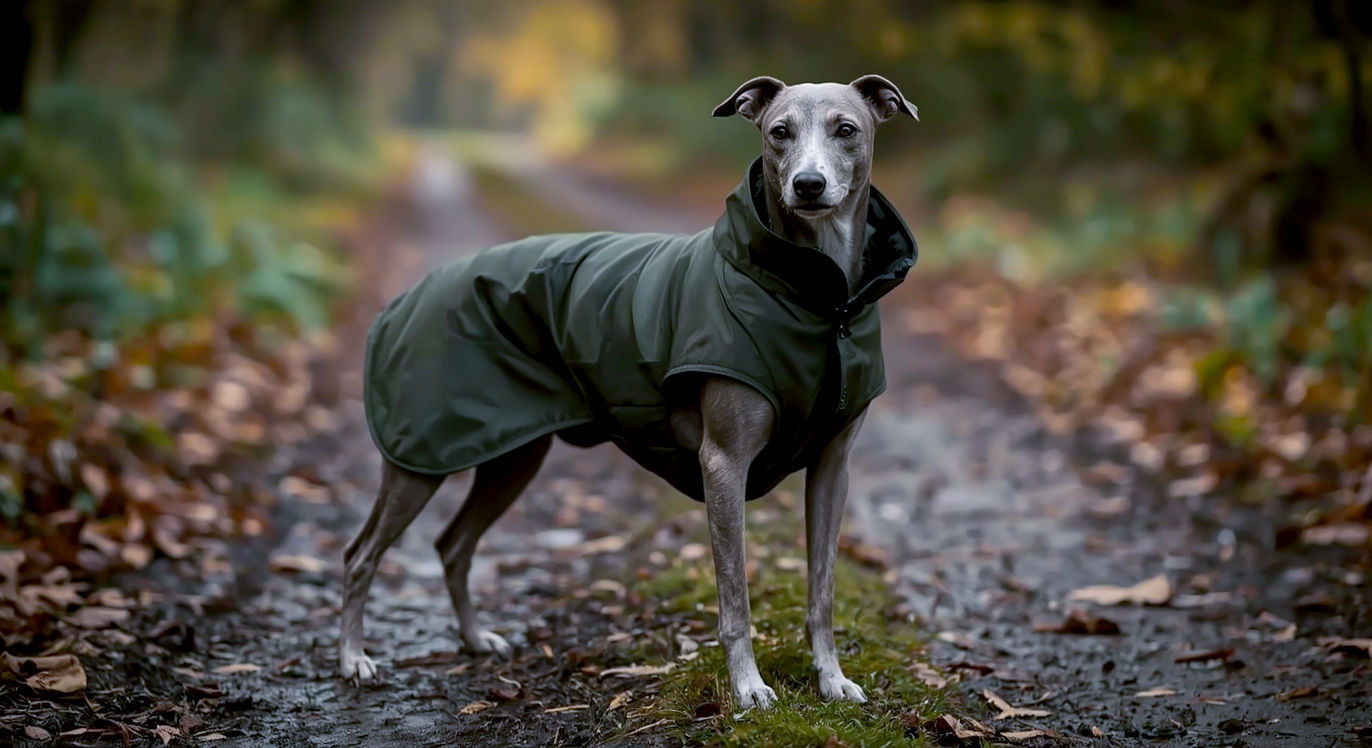The Great British Dog Apparel Guide: Keeping Your Four-Legged Friend Comfy, Safe, and Stylish
Your definitive guide to dog apparel in the UK. Discover why a coat is more than a fashion statement and how to choose the perfect fit for warmth, safety, and style.

This post may contain affiliate links. If you make a purchase through these links, we may earn a commission at no additional cost to you.
Let’s be honest, the British weather is nothing if not unpredictable. One minute it’s glorious sunshine in the park, the next you’re caught in a downpour that seems to come from nowhere. We humans have our trusty raincoats and wellies, but what about our dogs? For years, the idea of dressing up a dog was seen as a bit of a laugh, something reserved for tiny handbag dogs in American films. But that’s all changed. Today, dog apparel isn’t just about looking cute—it’s about comfort, safety, and practicality.
From a sturdy waterproof coat that keeps a Whippet warm on a frosty morning walk to protective boots for a Spaniel tackling rocky trails in the Lake District, the right gear can make a world of difference to your dog’s well-being. It’s not about fashion for fashion’s sake. It’s about understanding your dog’s needs, whether they’re a shivering Greyhound with very little body fat, an elderly Labrador with aching joints that need warmth, or a fluffy Pomeranian whose long fur gets matted and filthy after a muddy romp through the woods.
This guide is your one-stop shop for everything you need to know about dog apparel. We’ll walk you through why a coat might be a brilliant idea for your canine companion, how to choose the perfect one, and how to measure your dog correctly so it fits like a glove. We’ll explore the different types of clothing, from cooling vests for those rare heatwaves to high-visibility jackets for dark winter evenings. Think of it as a wardrobe consultation for your best mate, ensuring they’re comfortable, protected, and, yes, maybe just a little bit stylish, whatever the British weather throws at you.
Why Bother with Dog Clothes? More Than Just a Pretty Jumper
It’s a fair question. Dogs have fur, right? Why would they possibly need a coat? Well, it’s not quite that simple. Just like humans, dogs come in all shapes and sizes, and their natural coats aren’t always enough to protect them from the elements.
Keeping Warm: Not All Dogs Are Built for a British Winter
For centuries, we’ve bred dogs for specific jobs. A Siberian Husky, with its thick double coat, is perfectly designed for freezing temperatures. A Chihuahua, on the other hand, originates from sunny Mexico and has a very thin coat. It’s simply not equipped to handle a damp, chilly day in Manchester.
Several types of dogs really benefit from an extra layer of warmth:
- Small and Toy Breeds: Dogs like Dachshunds, Pugs, and French Bulldogs have a larger surface area to volume ratio, meaning they lose body heat much more quickly. They can start shivering almost as soon as they step outside in winter.
- Slim, Short-Haired Breeds: Greyhounds, Whippets, and Vizslas are the supermodels of the dog world. They have very little body fat and fine, single-layered coats, offering minimal insulation. A warm, fleece-lined coat is a necessity, not a luxury, for these breeds.
- Elderly Dogs: As dogs get older, their circulation can become less efficient, and they may suffer from conditions like arthritis. The cold can make stiff joints even more painful. A warm, comfortable coat can help soothe their aches and encourage them to stay active.
- Puppies: Young puppies haven’t fully developed the ability to regulate their body temperature, making them vulnerable to the cold.
- Dogs with Medical Conditions: Certain illnesses can affect a dog’s ability to stay warm or might cause hair loss, making a protective layer essential.
A good rule of thumb is: if you feel cold enough to wear a coat, your dog might too, especially if they fall into one of these categories. Watch for signs like shivering, a hunched posture, or reluctance to walk.
Staying Dry: The Battle Against Rain and Mud
A wet dog isn’t just a smelly dog—it’s also a cold dog. When a dog’s fur gets soaked, it loses its insulating properties, and their body temperature can drop dangerously low. This is particularly risky for older dogs or those with health issues.
A good waterproof coat is a game-changer for daily walks. It keeps the rain off their back, meaning they stay warmer and more comfortable. And let’s not forget the clean-up operation post-walk. A full-body waterproof suit can drastically reduce the amount of mud and grime that gets tramped through your house. Instead of a full-on bath, you might just need to wipe their paws. It’s a win-win for everyone.
Protection from the Elements (and More)
Dog apparel offers more than just warmth and dryness. It can be a vital piece of safety equipment.
- Be Seen, Be Safe: High-visibility jackets and accessories are essential for walks in the early morning, late evening, or on foggy, overcast days. Bright colours like fluorescent yellow or orange, combined with reflective strips, make your dog easily visible to cyclists, drivers, and other pedestrians. This is crucial when walking near roads, especially in rural areas with no streetlights.
- Summer Safety: While we don’t get endless sunshine, British heatwaves can be intense. For dogs, especially those with dark coats or thick fur, overheating is a serious risk. Cooling vests and coats, which work by evaporation, can help regulate their body temperature during hot weather. Similarly, for dogs with pale skin or thin fur (like Bull Terriers), a lightweight UV-protection shirt can prevent sunburn.
- Paw Protection: Our pavements can get surprisingly hot in summer, hot enough to burn a dog’s sensitive paw pads. In winter, grit and salt used to de-ice roads can cause chemical burns and irritation. Dog boots provide a protective barrier against these hazards, as well as sharp stones, broken glass, or rough terrain when you’re out hiking.
- Anxiety and Comfort: For some dogs, the gentle, constant pressure of a snug-fitting jumper or an anxiety vest (like a Thundershirt) can have a calming effect, much like swaddling a baby. This can be incredibly helpful during stressful situations like fireworks, thunderstorms, or car journeys.
The Dog’s Wardrobe: Choosing the Right Gear for the Job
Once you’ve decided your dog could benefit from some apparel, the next step is choosing the right type. The market is flooded with options, so let’s break down the main categories.
Coats and Jackets: The Everyday Essential
This is the most common type of dog apparel in the UK. When choosing a coat, think about its primary purpose.
- Waterproof Raincoats: Look for coats made from materials like waxed cotton or synthetic fabrics with a waterproof membrane (similar to human raincoats). Key features to check for are taped seams (which prevent water from leaking through the stitching) and a good level of coverage over the back and underbelly. A high collar and a flap that covers the harness hole are also excellent features.
- Winter Coats: For cold weather, you’ll want a coat that is both warm and waterproof. Look for a durable, water-resistant outer layer and a soft, insulating inner layer like fleece or quilted padding. A good winter coat should cover the main muscle groups of the chest, back, and hindquarters without restricting movement.
- Fleece Jumpers and Vests: These are perfect for dry, chilly days or for adding an extra layer of warmth under a waterproof coat. They are also great for wearing around the house if you have a particularly cold-sensitive dog. They are soft, comfortable, and allow for a full range of motion, making them ideal for active dogs.
Jumpers and Hoodies: Cosy Comfort
Dog jumpers are less about hardcore weather protection and more about providing a bit of extra warmth and comfort. They’re fantastic for short-haired or older dogs to wear indoors on cold days, or for a quick trip outside when it’s not raining.
While dog hoodies can look adorable, be mindful of the hood itself. For most dogs, it’s purely a fashion accessory and can sometimes get in the way or obstruct their vision. Make sure it doesn’t bother your dog if you opt for a hooded style.
Cooling Apparel: Beating the Summer Heat
As our summers get warmer, cooling products are becoming more popular.
- Cooling Vests/Coats: These are typically made from a special fabric that you soak in cold water. As the water evaporates, it draws heat away from the dog’s body, providing a cooling effect. They are lightweight and designed to be worn during exercise or just for relaxing in the garden on a hot day.
- Cooling Bandanas: These work on the same principle as vests but are focused on the neck area, where major arteries are close to the skin, helping to cool the blood flow. They’re a less intrusive option for dogs who aren’t keen on wearing a full coat.
Boots and Paw Protection: For Happy, Healthy Feet
Dog boots might look a bit strange, but they serve a very practical purpose.
- When to Use Boots:
- On hot pavements to prevent burns.
- On icy, gritted ground to protect from salt and chemicals.
- On rough, rocky, or thorny terrain during hikes.
- To protect an existing paw injury and keep it clean.
- Getting the Right Fit: It’s crucial that boots fit snugly but not too tightly. If they’re too loose, they’ll rub and cause sores; if too tight, they’ll be uncomfortable and restrict circulation. Most brands provide a sizing guide based on paw width. It can take a dog some time to get used to wearing boots—expect some comical high-stepping at first! Introduce them slowly with lots of treats and praise.
High-Visibility Gear: Safety First
This is a non-negotiable for any dog owner who walks in low-light conditions.
- Vests and Jackets: A full high-vis vest offers the best visibility from all angles.
- Collars, Leads, and Harnesses: Even if your dog won’t wear a coat, a reflective or LED light-up collar can make a huge difference.
- Bandanas and Clip-on Lights: These are simple, cheap, and effective ways to boost your dog’s visibility.
A Perfect Fit: How to Measure Your Dog Correctly
An ill-fitting coat is not only uncomfortable for your dog, but it can also be dangerous. If it’s too tight, it can restrict movement and breathing, and cause chafing. If it’s too loose, it can get snagged on branches or slip and tangle around their legs.
Getting the right fit is easy if you take three simple measurements. Use a soft tailor’s tape measure for this.
- Back Length: This is the most important measurement for most coats. Measure from the base of the neck (where the collar sits) to the base of the tail. Make sure your dog is standing up straight and looking forward. Don’t measure up their neck or onto their tail.
- Chest Girth: Measure around the widest part of your dog’s chest, which is usually right behind their front legs. The tape measure should be snug, but you should be able to fit two fingers between it and your dog’s body.
- Neck Girth: Measure around the base of the neck, where their collar would naturally sit.
Top Tip: Always check the specific sizing guide for the brand you’re buying from. A ‘Medium’ in one brand can be very different from a ‘Medium’ in another. They will usually provide a chart that matches their sizes to these three key measurements. If your dog is between sizes, it’s often best to size up, especially for winter coats where you might want to layer a fleece underneath.
Choosing the Right Materials: Function Over Fashion
The material of a garment dictates its performance. Here’s a quick guide to what to look for:
- Outer Layers (for protection):
- Waxed Cotton: A classic British choice. It’s durable, waterproof, and develops a lovely character over time. It does require some maintenance (re-waxing) to keep it waterproof.
- Nylon/Polyester with Coating: These are modern, lightweight, and highly effective waterproof materials. Look for terms like ‘ripstop’ (which prevents tearing) and check the waterproof rating if available.
- Softshell: This material is water-resistant, windproof, and breathable. It’s great for active dogs on drizzly, windy days as it allows for a lot of movement and prevents them from overheating.
- Inner Layers (for warmth):
- Fleece: The go-to material for insulation. It’s soft, warm, lightweight, and dries quickly.
- Quilted/Padded Fill: Provides excellent warmth, often using synthetic insulation that stays warm even when damp.
- Cotton/Jersey: Comfortable and breathable, often used for lighter jumpers and t-shirts. However, cotton is not a good insulator when wet, so it’s best for dry conditions.
Key Features to Look For
When you’re comparing products, keep an eye out for these thoughtful design details:
- Adjustable Straps: Look for adjustable straps around the chest and neck (often using velcro or buckles) to help you get a secure, customised fit.
- Harness Hole/Zip: If your dog wears a harness, a dedicated opening on the back of the coat is essential. A simple hole is good, but a two-way zip is even better as it allows you to position the opening exactly where your harness lead attachment sits.
- Leg Straps: Elasticated leg straps for the back legs can help keep the coat in place and stop it from flapping up in the wind. However, some dogs don’t like them, so check that they are soft and not too tight.
- Reflective Details: Even on a non-hi-vis coat, reflective piping or logos are a great safety feature for low-light conditions.
- Machine Washable: Let’s face it, dog coats get muddy. Check the washing instructions—an easy-care, machine-washable coat will make your life much simpler.
Getting Your Dog Used to Wearing Clothes
Some dogs will happily let you put a coat on them from day one. Others might freeze on the spot, refuse to move, or try to wriggle out of it. The key is to make it a positive experience.
- Introduce it Slowly: Don’t just wrestle your dog into a new coat. First, let them sniff it and get used to its presence. Place it on the floor and reward them with treats for calmly investigating it.
- Short and Sweet: For the first few times, put the coat on for just a minute or two inside the house. Give them lots of praise and a high-value treat while they are wearing it, then take it off.
- Build Positive Associations: Start putting the coat on right before something they love, like a walk or dinner time. They will quickly learn that ‘coat on’ means good things are about to happen.
- Check for Comfort: Once the coat is on, check that none of the straps are twisted or too tight. Make sure they can move freely—toss a toy for them in the living room to see that their movement isn’t restricted.
- Never Force It: If your dog seems genuinely distressed, take a step back. Forcing them will only create a negative association. Go back to step one and proceed more slowly. Most dogs will accept apparel with a bit of patient, positive reinforcement training.
The Future of Dog Apparel: Trends and Innovations
The world of dog apparel is constantly evolving. What was once a niche market is now a booming industry, with new technologies and trends emerging all the time.
- Sustainable Materials: Just as in human fashion, there is a growing demand for eco-friendly pet products. Brands are now using recycled materials for both fabrics and insulation, as well as natural fibres like organic cotton and bamboo.
- GPS and Tech Integration: We’re starting to see coats and harnesses with built-in pockets for GPS trackers, allowing you to keep an eye on your dog’s location via your smartphone. In the future, we might even see apparel with integrated health sensors that can monitor a dog’s heart rate or temperature.
- Customisation and Bespoke Tailoring: For dogs with unusual body shapes (like Bulldogs or Dachshunds), finding an off-the-shelf coat that fits perfectly can be a challenge. A growing number of companies now offer made-to-measure services, creating a garment that is tailored to your dog’s exact measurements for ultimate comfort and performance.
- Matching Outfits: For the truly fashion-forward owner, matching your coat, jumper, or even your wellies with your dog’s gear is a growing trend. It’s a fun way to show the bond you share with your canine companion.
Your Dog Apparel Checklist: A Final Summary
Choosing the right apparel can feel overwhelming, but it all comes down to your dog’s individual needs. Before you buy, ask yourself these questions:
- What is the primary purpose? Is it for warmth, rain protection, visibility, or cooling? This will determine the type of garment you need.
- What is my dog’s breed and coat type? A long-haired German Shepherd has very different needs from a fine-coated Bedlington Terrier.
- How old is my dog and what is their health like? An older, arthritic dog will benefit from more warmth and coverage than a young, boisterous one.
- What kind of activities will we be doing? A coat for a gentle stroll around the block can be simpler than one designed for a strenuous hike up a mountain.
- Have I measured my dog correctly? Don’t guess the size! A proper fit is crucial for comfort and safety.
- Is it easy to put on and take off? A complicated design with lots of confusing buckles will be a pain for both of you.
Dressing your dog is no longer a novelty; it’s a key part of responsible dog ownership in the UK. By choosing the right gear, you’re not just making a style statement. You’re providing your loyal companion with the comfort and protection they need to enjoy their walks and adventures with you, no matter what the famously fickle British sky decides to do. So, embrace the coat, celebrate the jumper, and get out there and enjoy the great outdoors together, come rain or shine.
Further Reading & Reputable Resources
For those looking to explore further, these UK-based websites are highly respected for their products and advice:
- Ruffwear UK: A leading brand known for high-performance, durable outdoor gear for active dogs.
- Pets at Home: The UK’s largest pet supplies retailer, offering a wide range of apparel for all budgets and needs.
- Joules (Pet Collection): For those who appreciate classic British style, Joules offers a charming range of dog coats and accessories.
- DogFit: Specialising in gear for canicross and running with your dog, they offer excellent advice on performance harnesses and apparel.
- The Kennel Club: While not a retailer, their website offers a wealth of information on dog health, welfare, and breed-specific needs.






